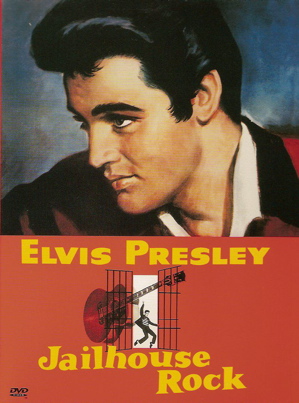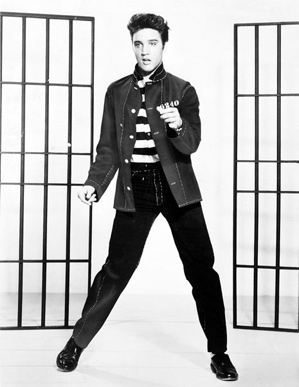Jailhouse Rock Chronicles:
A Prison, a Cow Bell, and a Riot Jailhouse Rock, Elvis Presley's third film, premiered in Memphis on October 17, 1957, and was
released nationwide on November 8. Variety listed it at #14 on its list of "Top Grossers of 1957,"
and in 2004 the film was selected for preservation in the United States National Film Registry for
being "culturally, historically, or aesthetically significant." While rating behind King Creole in
popularity with both critics and fans alike, Jailhouse Rock has proved to be Elvis's most historically
significant movie. Fifty years after its making, it remains a classic rock 'n' roll film.
 The following three anecdotes appeared in the press within a week following the release of The following three anecdotes appeared in the press within a week following the release of
Jailhouse Rock in November 1957. All three speak to the cultural impact of the film at the time. "Prison Chief Grimaces; 'Jailhouse Rock' Link to Carolina Unfavorable"
That was the headline over an article in Variety on November 13, 1957, just five days
after Jailhouse Rock's national release. It seems that about three minutes after the film's
opening credits, an outside view of the prison in which Vince Everett (Elvis) was to serve his
sentence for manslaughter, briefly flashed on the screen. A number of North Carolina residents
who viewed the film recognized the facility as their state's Central Prison, located outside Raleigh.
Speaking to reporters, North Carolina State Prisons Director W. F. Bailey expressed disappointment
that his state's penitentiary appeared as the "big house" in Presley's movie. According to Bailey,
Metro-Goldwyn-Mayer had not asked permission to use a shot of Central Prison in Jailhouse Rock.
"I wouldn't have allowed it if they'd contacted me," the director said.
In the Variety article, Bailey made it clear that he was not so much concerned about the outside view
of the prison as he was about the perception that the interior scenes of prison discipline involving
Presley in the movie were representative of what actually occurred in Central Prison. In particular,
he referred to the scene in which Presley's character is tied up and flogged for his part in a prison riot.
In the scene the callous film warden stands nearby and counts off the lashes.
 "We sure don't allow lashings here," Bailey told reporters. "We sure don't allow lashings here," Bailey told reporters.
"We absolutely do not. It's contrary to all our policies and rules."
According to Variety, no one in North Carolina seemed to
know how a view of Central Prison got into Jailhouse Rock.
One possibility is that stock footage may have been used in
a previous MGM film, possibly Carbine Williams.
"Bailey said he regretted the use of the state prison in the picture,"
explained the Variety article, "because fans who recognized it might
think that North Carolina prisons were run like the Hollywood version."
Threw Cow Bell at Presley, Out on Bail
This headline over a very brief article, also in Variety's November 13,
1957, issue, concerned a Texas man who found himself behind bars
as a result of his behavior during a theater showing of Jailhouse Rock.
The text of the article reads as follows.
"Metro's 'Jailhouse Rock' rocked a young Baytown, Tex., man right into
the local jail. His offense: Throwing a cow bell at Elvis Presley on [the]
theatre screen. Into the jailhouse went Earl Shanks, a little less than
48 hours after the cow bell incident at the Bronson Theatre. He was sprung
on $500 bond but faces malicious destruction of property rap."
Elvis Film Sparks 'Riot' of Juveniles'
Commotion on a much wider scale occurred at the Paramount Theater in
Oakland, California, at a showing of Jailhouse Rock on November 13, 1957. The next day, the Oakland Tribune
reported on the "riot."
A packed house had just finished viewing the 6 p.m. showing of Elvis's newest film when the action started. When
the theater lights went up to allow the audience to leave, five boys reportedly "grabbed" several girls as they walked
up the aisle. Other boys jumped to the girls' defense, and fistfights broke out.
Eighteen Oakland police officers responded to a riot call at the Paramount and found about 1,000 youths milling
around inside the theater. Fights were still breaking out, and one boy even took a swing at a special police officer.
The theater was closed down for an hour while officers suppressed the disturbance. Five boys were initially arrested,
but three were soon released. One 15-year-old was booked for disturbing the peace and resisting arrest. Another boy,
age 16, was held for disturbing the peace. Estimated damage to the Paramount building was assessed at about $1,000.
According to the Oakland Tribune, "The showing of 'Copper Sky,' the theater's second feature, was held up for an hour
while the management refunded money to more than 500 youngsters who panicked when the scattered fights broke out."
|
No hay comentarios:
Publicar un comentario